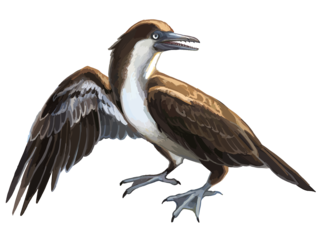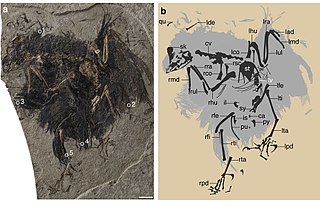
Microraptor is a genus of small, four-winged dromaeosaurid dinosaurs. Numerous well-preserved fossil specimens have been recovered from Liaoning, China. They date from the early Cretaceous Jiufotang Formation, 125 to 120 million years ago. Three species have been named, though further study has suggested that all of them represent variation in a single species, which is properly called M. zhaoianus. Cryptovolans, initially described as another four-winged dinosaur, is usually considered to be a synonym of Microraptor.

Confuciusornis is a genus of basal crow-sized avialan from the Early Cretaceous Period of the Yixian and Jiufotang Formations of China, dating from 125 to 120 million years ago. Like modern birds, Confuciusornis had a toothless beak, but closer and later relatives of modern birds such as Hesperornis and Ichthyornis were toothed, indicating that the loss of teeth occurred convergently in Confuciusornis and living birds. It was thought to be the oldest known bird to have a beak, though this title now belongs to an earlier relative Eoconfuciusornis. It was named after the Chinese moral philosopher Confucius. Confuciusornis is one of the most abundant vertebrates found in the Yixian Formation, and several hundred complete specimens have been found.

The Enantiornithes, also known as enantiornithines or enantiornitheans in literature, are a group of extinct avialans, the most abundant and diverse group known from the Mesozoic era. Almost all retained teeth and clawed fingers on each wing, but otherwise looked much like modern birds externally. Over eighty species of Enantiornithes have been named, but some names represent only single bones, so it is likely that not all are valid. The Enantiornithes became extinct at the Cretaceous–Paleogene boundary, along with Hesperornithes and all other non-avian dinosaurs.

Sinornithosaurus is a genus of feathered dromaeosaurid dinosaur from the early Cretaceous Period of the Yixian Formation in what is now China. It was the fifth non–avian feathered dinosaur genus discovered by 1999. The original specimen was collected from the Sihetun locality of western Liaoning. It was found in the Jianshangou beds of the Yixian Formation, dated to 124.5 million years ago. Additional specimens have been found in the younger Dawangzhangzi bed, dating to around 122 million years ago.

Yanornis is an extinct genus of fish-eating Early Cretaceous birds. Two species have been described, both from Liaoning province, China: Yanornis martini, based on several fossils found in the 120-million-year-old Jiufotang Formation at Chaoyang, and Yanornis guozhangi, from the 124-million-year-old Yixian Formation.

Jeholornis is a genus of avialan dinosaurs that lived between approximately 122 and 120 million years ago during the early Cretaceous Period in China. Fossil Jeholornis were first discovered in the Jiufotang Formation in Hebei Province, China and additional specimens have been found in the older Yixian Formation.

Cathayornis is a genus of enantiornithean birds from the Jiufotang Formation of Liaoning, People's Republic of China. It is known definitively from only one species, Cathayornis yandica, one of the first Enantiornithes found in China. Several additional species were once incorrectly classified as Cathayornis, and have since been reclassified or regarded as nomina dubia.

Eoconfuciusornis a genus of extinct avialan that lived 131 Ma ago, in the Early Cretaceous of China. It is the oldest known bird to have a beak.

Anchiornis is a genus of small, four-winged paravian dinosaurs, with only one known species, the type species Anchiornis huxleyi, named for its similarity to modern birds. The Latin name Anchiornis derives from a Greek word meaning "near bird", and huxleyi refers to Thomas Henry Huxley, a contemporary of Charles Darwin.
Chaoyangia is an extinct genus of euornithean birds, containing the single species Chaoyangia beishanensis. This species is known from a single fossil specimen consisting of a partial skeleton including vertebra, ribs, hips, and upper legs. The specimen was discovered in the Jiufotang Formation near the city of Chaoyang in Liaoning province, China. This rock formation has been dated to the Aptian age of the Early Cretaceous period, 120 million years ago.

Bohaiornis is a genus of enantiornithean dinosaurs. Fossils have been found from the Lower Cretaceous Jiufotang Formation of western Liaoning, China. The only known species, Bohaiornis guoi, was named by Dongyu Hu, Li Li, Lianhaim Hou and Xing Xu in 2011 on the basis of a fully articulated and well-preserved skeleton of a sub-adult. This specimen, LPM B00167, preserved two long, ribbon-like feathers attached to the tail rather than a fan of shorter pennaceous feathers. It was similar to the slightly older Eoenantiornis, but much larger in size. Bohaiornis is the type species of Bohaiornithidae, a family of large predatory enantiornitheans from the Early Cretaceous.
Parabohaiornis is an extinct genus of bohaiornithid enantiornithean dinosaur known from the Early Cretaceous of Liaoning Province, northeastern China. It contains a single species, Parabohaiornis martini.

Bohaiornithidae is a group of early predatory enantiornithean dinosaurs from the early Cretaceous Period of China. All known specimens come from the Jiufotang Formation and Yixian Formation, dating to the early Aptian age, 125–120 million years ago. Bohaiornithidae was first coined by Wang and colleagues in 2014. They defined it as the natural group formed by all descendants of the common ancestor of the type species, Bohaiornis guoi, and Shenqiornis mengi.

Longusunguis is an extinct genus of bohaiornithid enantiornithean dinosaur known from the Early Cretaceous of Liaoning Province, northeastern China. It contains a single species, Longusunguis kurochkini.
Dingavis is an extinct genus of ornithuromorph dinosaurs from the Early Cretaceous of present-day China. It contains a single species, D. longimaxilla.

Cruralispennia is an extinct genus of enantiornithean bird. The only known specimen of Cruralispennia was discovered in the Early Cretaceous Huajiying Formation of China and formally described in 2017. The type species of Cruralispennia is Cruralispennia multidonta. The generic name is Latin for "shin feather", while the specific name means "many-toothed". The holotype of Cruralispennia is IVPP 21711, a semi-articulated partial skeleton surrounded by the remains of carbonized feathers.

Eogranivora is a bird genus, belonging to the Ornithuromorpha, that lived in the area of present-day China during the Early Cretaceous. Its type species is Eogranivora edentulata.

Avimaia is a genus of fossil birds of the Enantiornithes clade that lived about 115 million years ago in Northwest China. The only known species is A. schweitzerae. The holotype fossil of the bird was found in the Xiagou Formation, and is noted as the first discovered fossil bird with an unlaid egg. Abnormalities, including egg binding in which the egg becomes stuck within the body of the bird causing death, were found in the egg suggesting that the preserved egg may have caused this bird's demise. Egg binding is a serious and lethal condition that is fairly common in small birds undergoing stress.

Jingmai Kathleen O'Connor is a paleontologist who works as a curator at the Field Museum.

Meilifeilong is an extinct genus of chaoyangopterid pterosaurs from the Early Cretaceous Jiufotang Formation of China. The genus contains two species: M. youhao, known from an almost complete skeleton and a partial skull, and M. sanyainus, originally described as a species of Shenzhoupterus. The Meilifeilong youhao holotype represents the best-preserved and most complete chaoyangopterid discovered so far.















